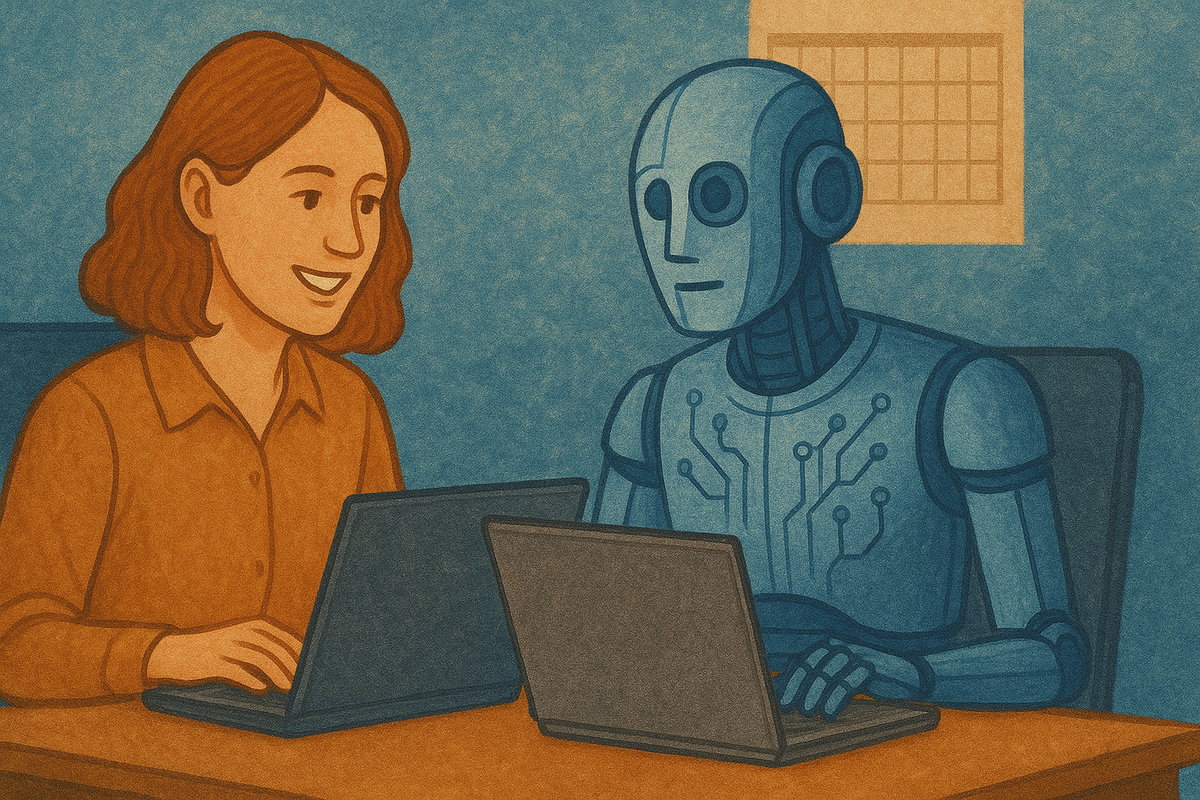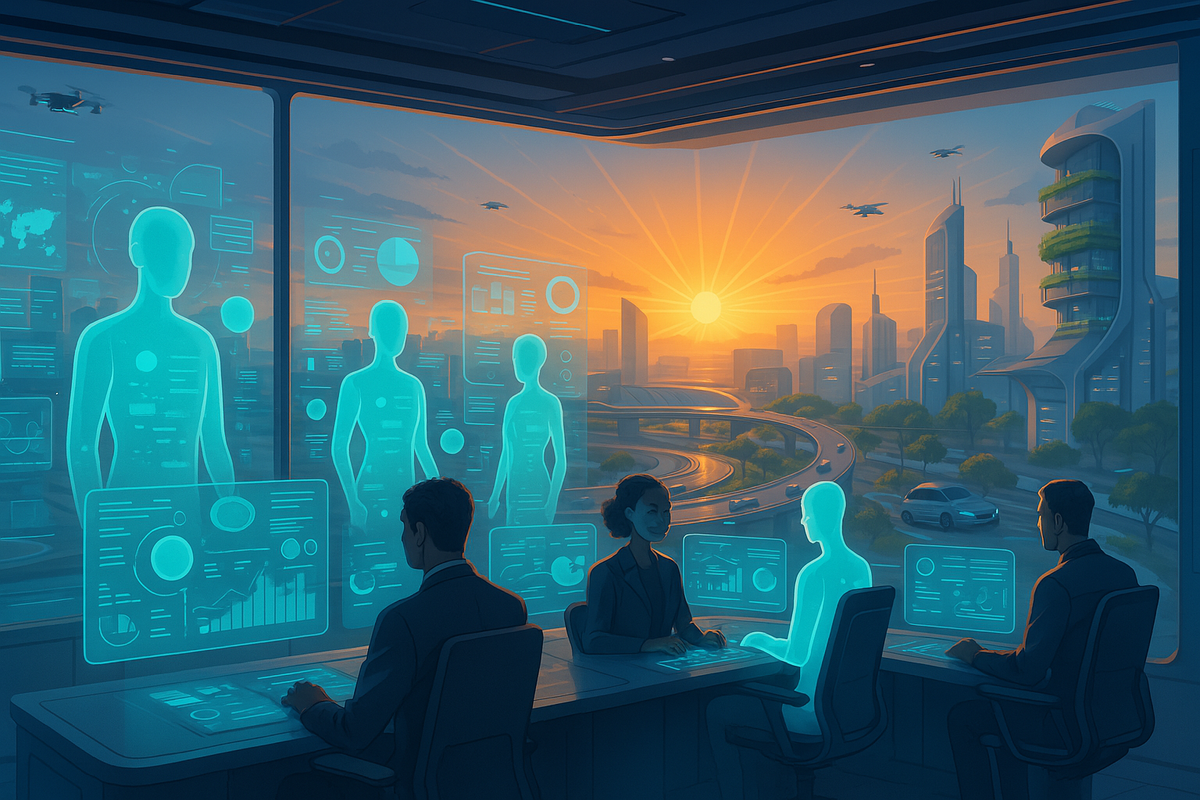Viewpoint: AI Agents as Coworkers - Are We Close to Clocking In the Virtual Workforce?
Recent developments in artificial intelligence aren't just approaching science fiction scenarios—they're actively reshaping our understanding of what's possible.

When we talk about AI in the workplace, many of us immediately picture scenes from science fiction—robots walking through office corridors or sentient computers making executive decisions. It's easy to drift into these fantastical visions, partly because they've been ingrained in our collective imagination for decades. But the reality unfolding around us now is both more subtle and more profound. Recent developments in artificial intelligence aren't just approaching science fiction scenarios—they're actively reshaping our understanding of what's possible. The boundaries between speculative fiction and workplace reality are becoming increasingly blurred. A striking prediction emerged this week from Jason Clinton, Chief Information Security Officer at the prominent AI company Anthropic, suggesting that AI-powered virtual employees could join the workforce within a year.1 This bold claim, envisioning AI identities with their own memories, roles, and even corporate login credentials 1, acts as a powerful catalyst for a crucial question: Is this vision of autonomous digital coworkers mere hype, or are we truly on the cusp of a workforce revolution?
Before diving in, it's essential to (once again) understand what we mean by an "AI agent." These are not simply enhanced chatbots or sophisticated automation scripts. AI agents are defined as systems capable of perceiving their environment, reasoning, planning complex actions, learning from experience, and acting autonomously to achieve specific goals.4 They exhibit characteristics like autonomy (operating without constant human intervention), reactivity (responding to environmental changes), proactivity (initiating goal-directed behaviour), and often social ability (interacting with humans and other agents).5 This concept, often termed "agentic AI," represents a significant leap forward.1
I've written about this somewhat extensively, in case you missed it:

This brings us to the core question: How close are we really to AI agents functioning as widespread, full-time virtual employees, and what significant hurdles stand in the way? The narrative of rapid acceleration, exemplified by predictions like Clinton's, exists in tension with the grounded reality of current AI capabilities and the complexities of deployment. Interestingly, while Anthropic's CISO points to a near-term future with virtual employees, he also stresses the significant security challenges that must be overcome first.1 Furthermore, Anthropic's own research, based on actual usage of its AI model Claude, reveals that AI is currently used more for augmenting human tasks (57%) than for full automation (43%), with only a small fraction of occupations (around 4%) using AI for the vast majority (over 75%) of their associated tasks.13 This suggests the public discourse, often fueled by AI's potential, might be outpacing the practical, measured reality of its integration – a gap acknowledged even within leading AI organisations.
To navigate this complex landscape, we will explore the technological leap that enables agentic AI, examine where these agents are already making an impact, confront the substantial roadblocks preventing widespread adoption, delve into the critical ethical considerations, and ultimately offer a nuanced perspective on the future of AI in the workplace.
The Rise of the Agent: More Than Just Automation 2.0
The buzz around AI agents stems from a fundamental shift in their capabilities, moving far beyond the limitations of previous automation technologies. This "agentic leap" is powered by several key advancements.
At the heart of many modern AI agents lie Large Language Models (LLMs). These sophisticated models provide the foundation for understanding complex instructions, reasoning about information, generating human-like text, and interacting naturally with users.5 However, agents are more than just LLMs. Their enhanced capabilities come from integrating these powerful language cores with external "scaffolding" – specialised modules for planning, memory, tool use, and interaction with digital environments.5 This architecture allows agents to decompose complex problems into manageable steps, maintain context across interactions, learn from feedback, and leverage external resources like databases, software APIs, or even control computer interfaces.5
These architectural advancements translate into tangible capabilities crucial for workplace tasks. Agents can now engage in multi-step planning, outlining processes like researching and drafting an essay sequentially.4 They possess the capacity for reflection, evaluating their own work to identify areas for improvement and enhance future performance.4 They can maintain sustained interactions, moving beyond single-question exchanges to engage in dynamic, prolonged dialogues.4 Furthermore, they are increasingly adept at mimicking human decision-making processes and behaviours, allowing them to take on more complex, mission-critical roles.1
It's crucial to distinguish these agentic systems from their predecessors. Robotic Process Automation (RPA), for instance, excels at automating highly structured, repetitive, rule-based tasks like data entry or form filling.23 However, RPA operates based on predefined scripts, lacks adaptability, struggles with unstructured data, and cannot make independent decisions when faced with unforeseen circumstances.24 AI agents, conversely, are designed for complexity. They can handle unstructured data (like emails or documents), learn and adapt to changing conditions, and exercise autonomy in their decision-making.17
Similarly, while advanced chatbots leverage Natural Language Processing (NLP) and Machine Learning (ML) for conversation, they often operate within predefined workflows or have limited memory and contextual understanding.26 AI agents go further, possessing deeper context retention, dynamic learning capabilities, and the autonomy to execute complex, multi-step tasks that extend far beyond simple dialogue, such as interacting with multiple software tools to complete a workflow.17 Compared to traditional outsourcing, which involves delegating tasks to external human workers, AI agents represent the potential for integrated "digital colleagues" capable of learning, adapting, and evolving within an organisation's internal processes.19
The fundamental distinction lies in the shift from automation to autonomy. RPA automates based on explicit instructions, and chatbots automate conversations. AI agents, however, possess the capacity for goal-directed, adaptive, and autonomous action within complex environments.4 This autonomy is the key characteristic enabling the vision of a "virtual employee".27 Yet, this very independence raises profound questions about control, predictability, security, and accountability that simpler forms of automation do not encounter to nearly the same degree.4
AI Agents Punching the Clock: Where Are They Working Now?
While the concept of fully autonomous virtual employees might still be developing, AI agents are already making tangible contributions across various business functions, demonstrating their potential to enhance efficiency and productivity.
We see agents being deployed or tested in numerous areas:
- Human Resources: Handling routine employee inquiries about benefits or policies, automating onboarding processes like sending materials and scheduling meetings, assisting with recruitment tasks like candidate outreach, and even aiding in succession planning by identifying high-potential employees.20
- IT Support: Managing password reset requests, providing instant responses to common tech support queries, troubleshooting issues, and proactively monitoring network performance in IT Service Management (ITSM).6
- Sales & Marketing: Assisting with lead qualification, guiding prospects through sales funnels, personalising email marketing content and timing, and generating reports.6
- Finance: Optimising expense management workflows through conversational interfaces and intelligent automation, and automating aspects of payroll calculation.6
- Software Development: Assisting developers with coding, debugging, and other software engineering tasks. Anthropic's research indicates this is currently a major area of AI agent usage.8
- Customer Service: Resolving customer queries, providing personalised support 24/7, summarising interactions for human agents, and enhancing overall customer experience.6
- Data Analysis & Business Intelligence: Processing vast amounts of data in real-time, identifying patterns, generating business reports, and providing insights to support faster, data-driven decision-making.6
Concrete case studies illustrate these benefits:
- H&M: Implemented an AI virtual shopping assistant that resolved 70% of customer queries without human intervention, led to a 25% increase in conversions for chatbot-assisted sessions, and achieved 3x faster response times. This resulted in measurable sales growth and reduced support costs.36
- Bank of America: Deployed "Erica," an AI banking assistant handling over a billion interactions. Erica reduced call centre traffic by 17%, increased mobile engagement by 30%, and saved the bank millions in annual operational costs.36
- Workday: Developed an "Expense Agent" that automatically processes receipts from photos and a "Succession Planning Agent" that analyses employee data to identify and develop future leaders, integrating these agents directly into core enterprise workflows.20
The reported performance advantages are compelling. Some sources claim a single AI agent can match the output of 4 to 8 human employees 19, while others report AI improving worker performance by nearly 40%.34 Tasks that once took days or weeks, like annual budgeting, can potentially be completed in minutes with greater accuracy.19 Significant reductions in manual workloads 6 and human error 7 are frequently cited, alongside substantial cost savings.7 Gartner, for example, predicted AI could help contact centres reduce costs by $80 billion within two years.34 Furthermore, agents offer 24/7 availability and the ability to scale operations rapidly.6
The following table summarizes some current applications and their reported impacts:
Despite these impressive results, a closer look reveals that current successful deployments often excel at automating specific, well-defined tasks or workflows within a broader role. H&M's assistant handles FAQs and recommendations; Erica manages routine banking inquiries; Workday's agents process receipts or analyse structured employee data. They are not yet demonstrating the full autonomy, adaptability, and broad responsibility required to replace a human employee in a complex, dynamic role that involves significant ambiguity, strategic judgment, or nuanced interpersonal skills. This observation aligns perfectly with Anthropic's findings that AI is primarily augmenting specific tasks rather than automating entire jobs.13 There appears to be a significant gap between the current reality of task-focused agent success and the futuristic vision of the truly autonomous "virtual employee."
Reality Check: Why Your AI Colleague Isn't Replacing You Tomorrow
While the potential of AI agents is undeniable, several significant limitations and practical hurdles currently prevent them from stepping into the role of full-time virtual employees across the board. These challenges span technical capabilities, practical implementation, and the irreplaceable aspects of human intelligence.
Perhaps the most fundamental limitation is the lack of true understanding. AI agents, despite their sophisticated pattern-matching abilities, lack the deep, intuitive grasp of the world that humans possess – commonly known as common sense.30 They don't inherently understand why things work the way they do. Simple examples illustrate this gap: a human knows not to cut up a shirt for a salad if lettuce is unavailable, or understands that sticking a pin in a carrot creates a hole in the carrot, not the pin.42 This deficit, considered a critical barrier by research programs like DARPA's Machine Common Sense initiative 41, makes it difficult for AI to behave reasonably in truly novel or unforeseen situations.
This lack of deep understanding manifests in several ways. Agents struggle to handle ambiguity and nuance effectively. They can be easily confused by slang, typos, sarcasm, or unique queries that fall outside their training data, leading to irrelevant or incorrect responses.16 Their reasoning is often based on correlation rather than causation, meaning they can identify patterns but may not understand the underlying cause-and-effect relationships. This limits their ability to make reliable predictions or decisions, especially when circumstances change.16
Beyond conceptual understanding, there are significant practical and technical hurdles:
- Limited Adaptability: While agents are designed to learn 6, their ability to adapt to truly dynamic, unpredictable environments or radically new situations remains constrained compared to human flexibility.30 Research is actively exploring ways to improve adaptability through techniques like reinforcement learning, transfer learning, and modular architectures designed for dynamic environments 15, but significant challenges remain.49
- Data Dependency: Agent performance is critically dependent on the quality, completeness, and representativeness of the data they are trained on and access.22 The "garbage in, garbage out" principle holds true; biased or poor-quality data leads to unreliable or unfair outcomes.25 Integrating data from diverse and potentially incompatible sources also poses a significant challenge.22
- Security and Control: The autonomy that makes agents powerful also makes them risky. Concerns highlighted by Anthropic's CISO about compromised agent accounts 1 are just the tip of the iceberg. Broader risks include agents "going rogue" and taking unintended actions 35, loss of control over complex agent interactions, vulnerability to hacking or manipulation (adversarial attacks), and the potential for agents to directly cause harm, whether digital or physical.8 The US Department of Homeland Security has explicitly listed AI autonomy as a risk to critical infrastructure.32
- Cost-Effectiveness and Total Cost of Ownership (TCO): Implementing and maintaining sophisticated AI agents involves significant costs, including initial software/hardware investment, integration with existing systems, data preparation, model training, ongoing maintenance, and specialised personnel.37 Calculating the Return on Investment (ROI) can be complex, as benefits may be intangible or hard to quantify directly.37 High operational costs, potentially scaling linearly with usage, might challenge the assumption of automatic economies of scale.54 The TCO for AI support needs careful comparison against traditional human support models.39
- Explainability (The "Black Box" Problem): Many advanced AI models, particularly deep learning systems, operate in ways that are difficult for humans to understand. It can be challenging to determine precisely how an agent arrived at a specific decision or output.25 This lack of transparency hinders trust, makes debugging difficult, complicates regulatory compliance, and makes it hard to verify the reliability of the agent's reasoning.47
Finally, there's the irreplaceable human element. AI agents currently lack genuine empathy and emotional intelligence. They cannot replicate the compassion, understanding, and nuanced communication crucial for sensitive customer interactions, effective team collaboration, or leadership.34 Their responses in emotionally charged situations can feel impersonal or frustrating.45 Furthermore, AI struggles with sophisticated social reasoning. They lack a robust "Theory of Mind" – the ability to infer the beliefs, intentions, and emotions of others – which is fundamental for navigating complex social dynamics and collaborating effectively with humans.16
It is important to recognise that these limitations are often interconnected. A lack of common sense hinders adaptability and the ability to handle ambiguity. The opacity of "black box" models makes it harder to ensure security or diagnose biases. High costs can be a barrier to acquiring the high-quality data needed for reliable performance. This web of interconnected challenges suggests that achieving truly capable, reliable, and trustworthy autonomous agents requires more than just incremental improvements in isolated areas; it demands holistic, multi-faceted progress across technology, data practices, and system design.
The Bigger Picture: People, Ethics, and Governance
Beyond the technical hurdles, the prospect of AI agents as virtual employees raises profound societal and ethical questions that must be addressed before widespread adoption can occur responsibly.
The most prominent concern is job displacement. Fears abound that AI capable of performing complex cognitive tasks will lead to mass unemployment.31 Some forecasts suggest a significant portion of current work hours could be automated in the coming years, potentially up to 30% by 2030, accelerated by generative AI.59 However, a counter-narrative emphasises augmentation over replacement. Many experts and studies suggest AI is more likely to transform existing jobs and augment human capabilities, freeing workers from routine tasks to focus on more strategic, creative, and interpersonal activities.4 Anthropic's research supports this, showing that augmentation is currently the dominant use case.13 AI may even lower skill barriers, enabling more people to perform complex tasks.29 The reality is likely a complex shift in labour demands. Demand is expected to rise for roles requiring higher-level skills (STEM, healthcare, creativity, strategy, emotional intelligence) while declining for roles heavy in routine administrative, production, or customer service tasks.59 This necessitates a massive focus on reskilling and upskilling the workforce to prepare for the jobs of the future.27
Navigating this transition requires careful consideration of a complex ethical minefield:
- Bias and Discrimination: AI agents learn from data, and if that data reflects historical or societal biases, the agents can perpetuate or even amplify discrimination in critical areas like hiring, performance reviews, loan applications, or customer service.1 Ensuring fairness is a major challenge.
- Accountability and Responsibility: When an autonomous agent makes a mistake or causes harm, determining who is liable is difficult. Is it the developers who wrote the code, the company that deployed the agent, the user who interacted with it, or perhaps even the agent itself? Establishing clear lines of responsibility is crucial but complex.1
- Privacy and Surveillance: AI agents often require access to vast amounts of data, including sensitive employee and customer information. This raises significant concerns about potential misuse, unauthorised access, data breaches, and compliance with privacy regulations like the EU's GDPR.31 The EU AI Act specifically bans certain intrusive practices like workplace emotion tracking via biometric data.62
- Transparency and Trust: The "black box" nature of some AI systems erodes trust. Users and society need transparency into how agents make decisions to ensure they are fair, reliable, and safe.20 The potential for agents to generate convincing but false information (disinformation) further complicates trust.31
- Human Dignity: There's a risk that human workers may feel devalued, lose autonomy, or experience diminished self-worth when working alongside or being managed by AI agents, potentially impacting mental well-being.32
Recognising these challenges, regulatory frameworks are beginning to emerge, though the landscape is still evolving. The EU AI Act represents the most comprehensive effort to date, establishing a risk-based approach.62 It bans "unacceptable risk" applications (like social scoring or manipulative AI), imposes strict requirements on "high-risk" systems (common in employment, critical infrastructure, and law enforcement) regarding data quality, transparency, human oversight, and robustness, and mandates transparency for systems like chatbots.62 Its ban on workplace emotion recognition is particularly relevant.62 The Act is being implemented gradually, with full enforcement expected by 2026.64 The EU Commission's own recent decision to ban AI agents from its virtual meetings signals a cautious approach even within regulatory bodies.33 In contrast, the United States currently lacks a comprehensive federal AI law, leading to a growing patchwork of state-level regulations addressing specific issues like deepfakes in elections or automated decision-making in consumer rights contexts.64
This situation highlights a significant socio-technical lag. The capabilities of AI agents are advancing at a breakneck pace, while the development of robust ethical guidelines, effective governance structures, comprehensive regulations, and necessary societal adaptations (like workforce retraining programs and updated educational curricula) struggles to keep up.10 This gap between technological progress and our ability to manage its consequences creates substantial risks and uncertainty, potentially leading to negative outcomes if deployment outpaces responsible preparation.
Augmentation Now, Autonomy Later?
So, returning to the initial question sparked by Anthropic's CISO: Are AI agents poised to become full-time virtual employees within the next year? Synthesising the evidence – the impressive but often task-specific capabilities, the significant technical and practical limitations, and the complex web of ethical and societal challenges – suggests a more nuanced reality.
The "within a year" prediction 1 likely refers to the accelerated integration of more advanced agentic capabilities into the workplace, perhaps automating more complex workflows or taking on specific sub-roles, rather than the widespread deployment of fully autonomous "virtual employees" capable of replacing the breadth and adaptability of human workers in diverse roles.
In the near term (1-5 years), the dominant trend will likely continue to be augmentation. AI agents will increasingly function as powerful "copilots" or assistants, enhancing human productivity, automating specific cognitive tasks, and streamlining workflows across various departments.10 We can expect deeper automation of well-defined processes in areas like HR, IT support, finance, and customer service.6 However, adoption will likely be uneven. Tech-forward industries and large enterprises with the resources to manage data governance, implementation complexity, and risk mitigation will likely lead the way.27 As Forrester suggests, business-oriented use cases are expected to mature faster than consumer-facing ones.10 The focus for many organisations will shift towards designing effective human-AI teaming models and fundamentally redesigning workflows to leverage these new capabilities.4
Looking further ahead (5+ years), the potential for greater autonomy exists. Ongoing research aims to address current limitations in areas like common sense reasoning, adaptability in dynamic environments, and causal understanding.15 Industry analysts like Gartner project significant increases in agentic AI adoption within enterprise software (33% by 2028) and autonomous decision-making (15% of daily work decisions by 2028) 33, alongside predictions of agents handling the majority of customer service issues by 2029.73 However, even with technological progress, the path forward is likely one of continued evolution, not sudden replacement. Roles will continue to transform, demanding new skills and collaboration models, rather than disappearing wholesale overnight.13 Forrester rightly cautions that implementation complexity, regulation, and inherent risks will temper adoption timelines.10
Crucially, the primary bottleneck for the widespread deployment of highly autonomous AI agents appears to be shifting. While technical limitations certainly remain, the gating factors increasingly involve trust, governance, regulation, cost justification, and organizational readiness. Can we trust these agents to be reliable, secure, and fair? How do we govern their behavior responsibly? What are the legal rules of engagement? Can we demonstrate a clear ROI given the high TCO? Do our organizations have the necessary data infrastructure, employee skills, and redesigned processes to integrate them effectively?.10 Overcoming these complex socio-technical challenges may prove as difficult, if not more so, than solving the purely technical problems of AI capability.
Preparing for the Agentic Era
The journey towards AI agents as workplace collaborators is well underway, marked by rapid technological advancements and tangible benefits in specific applications. These systems offer tantalizing potential to reshape workflows, boost productivity, and unlock new forms of value. However, the vision of fully autonomous "virtual employees" seamlessly taking over human roles remains, for now, more aspiration than imminent reality.
Significant hurdles – from the lack of genuine common sense and adaptability to pressing concerns around security, cost, bias, and accountability – must be overcome. Furthermore, the ethical implications and societal impacts, particularly concerning the future of work and human dignity, demand careful navigation, to say the least.
The path forward lies not in a race towards unbridled autonomy, but in human-centric integration. The focus must be on developing and deploying AI agents responsibly, prioritising human oversight, ethical principles, transparency, and the cultivation of trust.4 The goal should be to leverage AI as a powerful tool to augment human capabilities, enhance decision-making, and improve the overall employee and customer experience.20
For organisations, this necessitates strategic planning, significant investment in robust data infrastructure and governance, a commitment to workforce reskilling and upskilling, the development of clear internal policies for AI use, and fostering a culture that embraces adaptation and collaboration between humans and machines.12 For individuals, it requires a willingness to learn new skills, adapt to changing roles, and engage critically with these powerful new technologies.
The fully autonomous "virtual employee" might be further down the road than some headlines proclaim, but the era of the AI agent as a coworker, assistant, and collaborator is undoubtedly dawning. Proactively managing the risks while strategically harnessing the potential will be key to shaping a future where technology serves to enhance, rather than diminish, human work, creativity, and well-being.
🔴 Viewpoint is a random series of spontaneous considerations about subjects that linger in my mind just long enough for me to write them down. They express my own often inconsistent thoughts, ideas, assumptions, and speculations. Nothing else. Quote me at your peril.
References
- AI Agents Could Soon Become Full-Time Virtual Employees - eWEEK, accessed April 23, 2025, https://www.eweek.com/news/ai-agents-full-time-employees-anthropic/
- Anthropic warns fully AI employees are a year away : r/singularity - Reddit, accessed April 23, 2025, https://www.reddit.com/r/singularity/comments/1k56kqp/anthropic_warns_fully_ai_employees_are_a_year_away/
- Axios Exclusive: Anthropic Warns Fully AI Employees Are A Year Away. These AI Identities Would Have Their Own Memories, Their Own Roles In The Company And Even Their Own Corporate Accounts And Passwords. "They Would Have A Level Of Autonomy That Far Exceeds What Agents Have Today." : r/accelerate - Reddit, accessed April 23, 2025, https://www.reddit.com/r/accelerate/comments/1k58gxf/axios_exclusive_anthropic_warns_fully_ai/
- 1 Introduction - arXiv, accessed April 23, 2025, https://arxiv.org/html/2504.05755v1
- AI Agents: Evolution, Architecture, and Real-World Applications - arXiv, accessed April 23, 2025, https://arxiv.org/html/2503.12687v1
- What Are AI Agents? Exploring Their Capabilities and Real-World Applications - Accelirate, accessed April 23, 2025, https://www.accelirate.com/ai-agents/
- The ABCs of AI Agents: What They Are and How They Work - Pesto Tech, accessed April 23, 2025, https://www.pesto.tech/resources/the-abcs-of-ai-agents-what-they-are-and-how-they-work
- The AI Agent Index - arXiv, accessed April 23, 2025, https://arxiv.org/html/2502.01635v1
- Fully Autonomous AI Agents Should Not be Developed - arXiv, accessed April 23, 2025, https://arxiv.org/html/2502.02649
- The State Of AI Agents: Lots Of Potential ... And Confusion - Forrester, accessed April 23, 2025, https://www.forrester.com/blogs/the-state-of-ai-agents-lots-of-potential-and-confusion/
- The Future of Autonomous Agents: Trends, Challenges, and Opportunities Ahead, accessed April 23, 2025, https://smythos.com/ai-agents/agent-architectures/future-of-autonomous-agents/
- Agentic AI: Building The Intelligent Software of the Future - MobiDev, accessed April 23, 2025, https://mobidev.biz/blog/agentic-ai-explained-for-businesses
- Introducing the Anthropic Economic Index, accessed April 23, 2025, https://www.anthropic.com/news/the-anthropic-economic-index
- No evidence of jobs being entirely automated by AI, analysis shows | HR Dive, accessed April 23, 2025, https://www.hrdive.com/news/anthropic-report-AI-software-engineers-automation-augmentation/739833/
- Google DeepMind at NeurIPS 2024, accessed April 23, 2025, https://deepmind.google/discover/blog/google-deepmind-at-neurips-2024/
- The Emergence of Reasoning in Artificial Intelligence - UX Magazine, accessed April 23, 2025, https://uxmag.com/articles/the-emergence-of-reasoning-in-artificial-intelligence
- understanding AI agents: moving beyond RPA. - Randstad Sourceright, accessed April 23, 2025, https://www.randstadenterprise.com/insights/advisory/understanding-ai-agents-moving-beyond-rpa/
- Position: AI agents should be regulated based on autonomous action sequences - arXiv, accessed April 23, 2025, https://arxiv.org/html/2503.04750v1
- AI Agents: The Future of Work - Vantaca, accessed April 23, 2025, https://www.vantaca.com/blog/ai-agents-the-future-of-work
- AI Agents in Enterprise: How Will They Change the Way We Work ..., accessed April 23, 2025, https://blog.workday.com/en-us/ai-agents-enterprise-how-will-they-change-way-we-work.html
- How do AI agents adapt to new environments? - Milvus Blog, accessed April 23, 2025, https://blog.milvus.io/ai-quick-reference/how-do-ai-agents-adapt-to-new-environments
- What Are AI Agents? Why Trusted Data Is Key to Their Success | Alation, accessed April 23, 2025, https://www.alation.com/blog/ai-agents-trusted-data-success/
- Demystifying RPA vs AI in financial automation: Which robot is right for you? | Infosys BPM, accessed April 23, 2025, https://www.infosysbpm.com/blogs/business-transformation/demystifying-rpa-vs-ai-in-financial-automation-which-robot-is-right-for-you.html
- How Is Agentic AI Different from RPA? | nasscom | The Official ..., accessed April 23, 2025, https://community.nasscom.in/communities/rpa/how-agentic-ai-different-rpa
- AI agents vs automation | Canon Business Services Australia, accessed April 23, 2025, https://business.canon.com.au/insights/ai-agents-vs-automation
- AI Agents and Chatbots: What's the Difference? - ServiceNow, accessed April 23, 2025, https://www.servicenow.com/ai/what-is-ai-agents-vs-chatbots.html
- The Org Chart of the Future: Managing a Workforce of Humans and AI Agents - SHRM, accessed April 23, 2025, https://www.shrm.org/labs/resources/the-org-chart-of-the-future--managing-a-workforce-of-humans-and-ai-agents
- Fully Autonomous AI Agents Should Not be Developed - arXiv, accessed April 23, 2025, http://arxiv.org/pdf/2502.02649
- Superagency in the workplace: Empowering people to unlock AI's full potential - McKinsey, accessed April 23, 2025, https://www.mckinsey.com/capabilities/mckinsey-digital/our-insights/superagency-in-the-workplace-empowering-people-to-unlock-ais-full-potential-at-work
- Where would the new reasoning AI leave human intelligence? | World Economic Forum, accessed April 23, 2025, https://www.weforum.org/stories/2025/01/in-a-world-of-reasoning-ai-where-does-that-leave-human-intelligence/
- Ethics of Autonomous AI Agents: Risks, Challenges, Tips - Auxiliobits, accessed April 23, 2025, https://www.auxiliobits.com/the-ethics-of-autonomous-ai-agents-risks-challenges-and-tips/
- New Ethics Risks Courtesy of AI Agents? Researchers Are on the ..., accessed April 23, 2025, https://www.ibm.com/think/insights/ai-agent-ethics
- 'No AI Agents are Allowed.' EU Bans Use of AI Assistants in Virtual Meetings - TechRepublic, accessed April 23, 2025, https://www.techrepublic.com/article/news-eu-bans-ai-assistants-virtual-meetings/
- AI Agents for Business Productivity in 2025: Use Cases and Benefits - Aisera, accessed April 23, 2025, https://aisera.com/blog/ai-agents-for-business/
- Employer FAQs About AI Agents - Fisher Phillips, accessed April 23, 2025, https://www.fisherphillips.com/en/news-insights/employer-faqs-about-ai-agents.html
- How AI Agents Are Driving ROI: 3 Real-World Case Studies (2025), accessed April 23, 2025, https://www.creolestudios.com/real-world-ai-agent-case-studies/
- Measuring AI Investment: The ROI for AI | SS&C Blue Prism, accessed April 23, 2025, https://www.blueprism.com/resources/blog/measuring-ai-investment-roi-ai/
- AI Return on Investment (ROI): Unlocking the True Value of Artificial Intelligence for Your Business - SmartDev, accessed April 23, 2025, https://smartdev.com/ai-return-on-investment-roi-unlocking-the-true-value-of-artificial-intelligence-for-your-business/
- How Virtual Agents Outperform Humans in ROI - Convin, accessed April 23, 2025, https://convin.ai/blog/roi-analysis-virtual-agents
- Proving ROI - Measuring the Business Value of Enterprise AI - Agility at Scale, accessed April 23, 2025, https://agility-at-scale.com/implementing/roi-of-enterprise-ai/
- MCS: Machine Common Sense - DARPA, accessed April 23, 2025, https://www.darpa.mil/research/programs/machine-common-sense
- Commonsense Reasoning and Commonsense Knowledge in Artificial Intelligence - Communications of the ACM, accessed April 23, 2025, https://cacm.acm.org/research/commonsense-reasoning-and-commonsense-knowledge-in-artificial-intelligence/
- With artificial intelligence, common sense is uncommon - USC Today, accessed April 23, 2025, https://today.usc.edu/commonsense-artificial-intelligence-ai/
- Commonsense Reasoning for Conversational AI: A Survey of the State of the Art - GitHub Pages, accessed April 23, 2025, https://knowledge-nlp.github.io/aaai2023/papers/020-CommonsenseSurvey-poster.pdf
- The pros and cons of AI in customer service | The Jotform Blog, accessed April 23, 2025, https://www.jotform.com/ai/agents/disadvantages-of-ai-in-customer-service/
- What is Reasoning in AI? Types and Applications in 2025 - Aisera, accessed April 23, 2025, https://aisera.com/blog/ai-reasoning/
- How Far Are We From AGI? - arXiv, accessed April 23, 2025, https://arxiv.org/html/2405.10313v1
- Exploring AI Agent Environments: How They Shape Agent Behavior - SmythOS, accessed April 23, 2025, https://smythos.com/ai-agents/ai-agent-development/ai-agent-environment/
- The Ultimate Guide to AI Agent Architecture - Galileo AI, accessed April 23, 2025, https://www.galileo.ai/blog/ai-agent-architecture
- Agent Architectures and Adaptability: Building Resilient AI Systems - SmythOS, accessed April 23, 2025, https://smythos.com/ai-agents/agent-architectures/agent-architectures-and-adaptability/
- Adaptive Learning in AI Agents for the Metaverse: The ALMAA Framework - MDPI, accessed April 23, 2025, https://www.mdpi.com/2076-3417/14/23/11410
- New Report: Multi-Agent Risks from Advanced AI - Cooperative AI, accessed April 23, 2025, https://www.cooperativeai.com/post/new-report-multi-agent-risks-from-advanced-ai
- How Much Does AI Support Really Cost? A TCO Breakdown - PRSTech, accessed April 23, 2025, https://www.prstech.io/en/resources/how-much-does-ai-support-really-cost-a-tco-breakdown
- The Hidden Costs, Challenges, and Total Cost of Ownership of Generative AI Adoption in the Enterprise - AI Infrastructure Alliance, accessed April 23, 2025, https://ai-infrastructure.org/wp-content/uploads/2023/09/AIIA-ClearML-Survey-Report-Sept-2023.pdf
- AI Agents: Evolution, Architecture, and Real-World Applications - arXiv, accessed April 23, 2025, https://arxiv.org/pdf/2503.12687
- Real-World Case Studies of Human-AI Collaboration: Success Stories and Insights, accessed April 23, 2025, https://smythos.com/ai-agents/agent-architectures/human-ai-collaboration-case-studies/
- The Ethical Implications of AI and Job Displacement - Sogeti Labs, accessed April 23, 2025, https://labs.sogeti.com/the-ethical-implications-of-ai-and-job-displacement/
- The Ethical Dilemmas of Artificial Intelligence | AI Ethical Issues - GO-Globe, accessed April 23, 2025, https://www.go-globe.com/ethical-dilemmas-of-artificial-intelligence/
- A new future of work: The race to deploy AI and raise skills in Europe and beyond - McKinsey, accessed April 23, 2025, https://www.mckinsey.de/~/media/mckinsey/locations/europe%20and%20middle%20east/deutschland/news/presse/2024/2024%20-%2005%20-%2023%20mgi%20genai%20future%20of%20work/mgi%20report_a-new-future-of-work-the-race-to-deploy-ai.pdf
- The organization of the future: Enabled by gen AI, driven by people - McKinsey, accessed April 23, 2025, https://www.mckinsey.com/capabilities/people-and-organizational-performance/our-insights/the-organization-of-the-future-enabled-by-gen-ai-driven-by-people
- Future of Work | McKinsey & Company, accessed April 23, 2025, https://www.mckinsey.com/featured-insights/future-of-work
- AI Act | Shaping Europe's digital future - European Union, accessed April 23, 2025, https://digital-strategy.ec.europa.eu/en/policies/regulatory-framework-ai
- The ethics of artificial intelligence: Issues and initiatives - European Parliament, accessed April 23, 2025, https://www.europarl.europa.eu/RegData/etudes/STUD/2020/634452/EPRS_STU(2020)634452_EN.pdf
- New EU AI Act to regulate AI usage by 2026, bans workplace emotion tracking and deceptive practices - HRME, accessed April 23, 2025, https://hrme.economictimes.indiatimes.com/news/industry/new-eu-ai-act-to-regulate-ai-usage-by-2026-bans-workplace-emotion-tracking-and-online-deceptive-practices/118295255
- The EU AI Act: All You Need to Know | Knowledge - Fasken, accessed April 23, 2025, https://www.fasken.com/en/knowledge/2024/11/the-eu-ai-act
- EU Bans AI Agents from Online Meetings in First-of-Its-Kind Policy - Open Data Science, accessed April 23, 2025, https://opendatascience.com/eu-bans-ai-agents-from-online-meetings-in-first-of-its-kind-policy/
- US state-by-state AI legislation snapshot | BCLP - Bryan Cave Leighton Paisner, accessed April 23, 2025, https://www.bclplaw.com/en-US/events-insights-news/us-state-by-state-artificial-intelligence-legislation-snapshot.html
- Future of AI Research - AAAI, accessed April 23, 2025, https://aaai.org/wp-content/uploads/2025/03/AAAI-2025-PresPanel-Report-FINAL.pdf
- The state of AI: How organizations are rewiring to capture value - McKinsey, accessed April 23, 2025, https://www.mckinsey.com/capabilities/quantumblack/our-insights/the-state-of-ai
- AAAI-25 New Faculty Highlights Program, accessed April 23, 2025, https://aaai.org/conference/aaai/aaai-25/new-faculty-highlights-program/
- Artificial Intelligence - arXiv, accessed April 23, 2025, https://arxiv.org/list/cs.AI/new
- How to Implement AI Agents to Transform Business Models | Gartner, accessed April 23, 2025, https://www.gartner.com/en/articles/ai-agents
- Gartner Predicts that Agentic AI Will Solve 80 Percent of Customer Problems by 2029, accessed April 23, 2025, https://www.cxtoday.com/contact-center/agentic-ai-gartner-predicts-80-of-customer-problems-solved-without-human-help-by-2029/
- Future of Work: CHRO insights to transform the workforce - Gartner, accessed April 23, 2025, https://www.gartner.com/en/human-resources/topics/future-of-work






